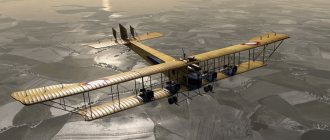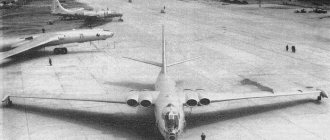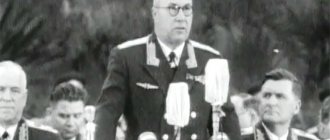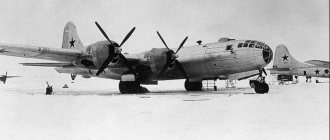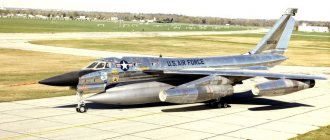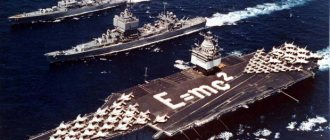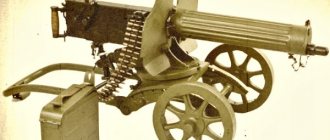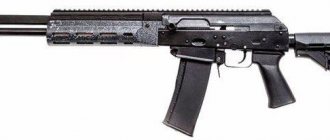The Arado Ar-234, which became the world's first jet bomber, was originally designed as a reconnaissance aircraft.
Its design under the leadership of V. Blum began in 1940. The basis was the task of developing a high-speed reconnaissance jet aircraft with a flight range of at least 2150 km. The project under the brand name E370 was a single-seat monoplane with a thin, straight, high wing and conventional tail. The pilot's cabin was pressurized and equipped with an ejection seat. The power plant chosen was two Jumo 004 turbojet engines located in nacelles under the wing. Initially, it was planned to use a resettable launch trolley and removable landing skis.
In February 1942, the company received an order to build 6 prototypes, but work was slow due to problems with engine development. The first prototype of the Ar-234V1 was flown only on June 15, 1943, and by November three more vehicles were tested. By that time, it was decided to abandon the development of the Ar-234A variant in favor of the Ar-234B with a conventional retractable landing gear (with a nose gear). The first aircraft with such a chassis (Ar 234V9) made its first flight on March 10, 1944, and production of pre-production Ar-234B-0 began in June.
The total number of aircraft produced by the plant in Al-Lonnewitz is estimated at 210 (according to other sources, 214) aircraft.
Main modifications of the Arado Ar-234
Ar 234 V - Jumo 004V engines with a thrust of 900 kgf. 20 pre-production Ar-234B-0 were used mainly for various tests. Ar-234B-1 was a reconnaissance aircraft. The main variant was the Ar-234B-2 - a bomber capable of lifting up to 1,500 kg of combat load (1,500 kg bomb under the fuselage and 2 under the engine nacelles). Under the engine nacelles, 2,300-liter PTB can be suspended. There is also an opinion that the Ar-234В-1 remained only in the project, and the Ar-234В-2, equipped with the appropriate modification kits, were used as reconnaissance aircraft. Also, the information found in publications about arming the Ar-234B-2 with 2 fixed 20-mm MG 151/20 cannons firing backwards is not confirmed - this option was considered, but apparently was not used in practice.
Arado Ar 234 C is a four-engine version with a BMW 003A turbojet engine (800 kgf) located in twin engine nacelles. The prototype of this modification, the Ar-234V8, has been tested since February 1944. Serial production began in February 1945 in two versions - the bomber Ar-234C-3 and the reconnaissance Ar-234C-4. The reconnaissance aircraft was armed with 2 20-mm cannons firing backwards, the bomber with an additional 2 firing forwards; the latter also carried up to 1500 kg of bombs. Before the end of the war, they managed to assemble about two dozen bombers and several reconnaissance aircraft.
T. Stepanov. “M-Hobbi”, no.?, 19??Whatever you want, I don’t like German cars. None. The German design school is generally quite unique - no matter what these guys tried to do, they always came up with irons. Crawling irons, floating irons and flying irons. Their cars always had too much pragmatism, which cannot be compared with the American scope and imagination. However, I have always had an interest in jet engines from the era of the Third Reich. It’s not that I like them, no, it’s just that they have always been a mystery to me - something like dangerous animals, some kind of force is drawn to their cages. These monsters, generated by an unprecedented rise in design ideas that accompanied the agony of one of the most terrible regimes, have been attracting lovers of technical exoticism for decades. Especially this car. By the way, her appearance is not at all German, and she seems to stand apart from other German designs.
I am not the first, or even the hundredth, to write on this topic and I do not intend to claim completeness of the presentation - everything has been written a long time ago. My job is just to give you a few facts in addition to the beautiful drawings.
As the second jet aircraft in service with the Luftwaffe, the Ar 234 became the world's first jet bomber. The development of the aircraft began at the end of 1940 in accordance with the technical specifications of the Ministry of Aviation for a high-speed reconnaissance aircraft with two turbojet engines, which were being developed at that time by BMW and Junkers.
At the end of 1941, the design team, headed by engineers Blum and Rebesky, began developing the Ar E-370 project, which later received the designation Ar 234 - a high-wing jet aircraft with engines under the wing. Since there was no space for the landing gear in the fuselage, which had a very small midsection, two schemes were initially worked out. According to one nickname, there were a large number of small wheels under the fuselage, and supporting skis under the engine nacelles. According to another scheme, which was ultimately adopted, the machine used a special drop-off trolley for takeoff, and landing was carried out on three ejectable skis.
Two prototypes - Ar 234V1 (Ministry of Aviation registration code TG+KB) and V2 (code DP+AW) were completed in the winter of 1941-42, but it was not until February 1943 that the first pair of Junkers 004B-0 engines were delivered to the Arado assembly plant in Warnemünde. The first prototype began trial taxiing in March and was delivered to Rhine Air Base in May, powered by two Junkers 004B-0 engines for flight testing. The aircraft made its first flight on June 15, 1943, with test pilot Captain Zelle in the cockpit. Everything went fine, however, the brake parachutes of the dropped cart did not open, and the cart was destroyed. The same thing happened with the second cart, and finally it was decided to drop the cart immediately after takeoff, and not at an altitude of 60 meters, as previously assumed. On August 25, 1943, the third prototype, Ar 234V3 (DP+AX), took off. Created as a prototype of the production Ar 234A, it had a pressurized cabin, an ejection seat and take-off rocket boosters, but was destroyed in one of its first flights.
On September 15, a similar Ar 234V4 (DP+AY) appeared, and then, on December 20, Ar 234V5 (GK+IV), equipped with two Junkers 004V-0 engines with a thrust of 850 kg.
The Ar 234V6 (GK+IW), which took off for the first time on April 8, 1944, had four BMW 003A-1 turbojet engines with a thrust of 8OO kg each, located in four separate engine nacelles.
Ar 234V7 (T9+MH) was the last prototype of the A series and was equipped with two Junkers 004B-1 engines with a thrust of 900 kg. During one of the first flights, the left engine caught fire and the control rods inside the wing were burned out. While trying to land the plane, the chief test pilot of the Arado company, Captain Zelle, died.
The V8 prototype (GK+IY serial number 130008) had four BMW003A-1 engines, however, unlike the V6, they were located in twin nacelles. It is this arrangement that will subsequently be used on machines of the C family.
Although the take-off trolley and skis were now working normally, it was clear that the immobility of the aircraft after landing would be a serious disadvantage in combat use. It was decided to equip the car with a conventional wheeled chassis. The fuselage was expanded to accommodate the struts and wheels approximately halfway along its length, and the nose strut was located under the cockpit.
discuss on the forum
Flight characteristics of the Arado Ar-234B-2 aircraft
- Engines: Jumo 004B
- quantity x thrust, kgf: 2×900
- Wingspan, m: 14.1
- Aircraft length, m: 12.6
- Aircraft height, m: 4.3
- Wing area, sq. m.: 25.5
- Weight, kg:
- empty aircraft: 5200
- normal takeoff: 8417
- maximum takeoff: 9858
- Maximum speed, km/h: 740
- Time to climb 6000 m with 500 kg. bombs: 12.8
- from 1500 kg. bombs: 17.5
- Practical ceiling, m: 10,000
- Flight range, km:
- without bombs: 1620
- from 500 kg. bombs: 1550
- from 1500 kg. bombs: 1100
Operators[edit]
| In this section do not cite any sources . |
France
- French Air Force - two captured Luftwaffe aircraft.
Nazi Germany
- Luftwaffe 1./Versuchsverband OKL, headquarters
- Sonderkommando Götz (named after pilot Horst Götz), two prototype aircraft, was then increased in size and became;
- Sperling's Sonderkommando conducted reconnaissance on the Western Front and in Britain and helped train crews;
- 1. / Fernaufklärungsgruppe
(FAGr) 123 (Long-range reconnaissance) - Sonderkommando Hecht, carried out reconnaissance of the southern part of the Western Front, and was also intended to train crews;
- 1./FAGr 100 (Reconnaissance unit)
- Sonderkommando Sommer (named after the pilot Erich Sommer), carried out reconnaissance in Italy and was also intended to train crews;
- 1./FAGr 33 (Reconnaissance unit)
- Sonderkommando Bonou, (night fighter squad)
- Kampfgeschwader 76 (Bomber unit)
Combat use of Arado Ar-234
Even at the prototype stage, the Ar-234 was involved in combat operations, initially reconnaissance. The first combat mission took place on August 2, 1944, when an Ar-234V7 carried out reconnaissance of the Normandy coast. In subsequent weeks, Ar-234s also appeared over England. By the end of 1944, such aircraft were operated in 4 long-range reconnaissance detachments.
Photo of Arado Ar-234
Of the bomber units, the HI/KG 76 group was the first to receive the Ar-234B-2. By the beginning of October, it had 54 aircraft, but their introduction into battle was delayed due to difficulties in mastering jet machines. The first combat mission took place on December 24, 1944, when 9 Ar-234B-2 bombed the railway junction in Liege and industrial enterprises in Namur. Flights against targets in Belgium continued in the following days. At dawn on January 1, 1945, as part of Operation Bodenplatte, 6 Ar-234B-2s attacked the Gilze-Rijen airfield, and late in the evening 4 aircraft bombed the docks in Antwerp. Subsequently, until the end of January, the combat activity of the Blitz was seriously limited by bad weather. On February 14 and 21, raids were carried out on concentrations of enemy troops near Eindhoven (16 and 21 aircraft took part, respectively). In the third decade of February, combat work became more intense, which immediately affected the level of losses - the Ar-234B turned out to be defenseless against Allied fighters. From 7 to 17 March, the main target for Arado was the bridge over the Rhine in Remagen. During his attacks, serious losses were suffered, but the object was not destroyed. Along with HI/KG 76, aircraft from other units that managed to receive the Ar-234B—detachment 6./KG 76 and headquarters unit KG 76—participated in the raids.
In the last days of the war, Ar-234B aircraft attacked advancing Soviet units. So, on April 26, KG 76 headquarters planes bombed a tank column on the outskirts of Berlin. On May 3, detachment 8./KG 76 received 4 Ar-234С-3, but they only managed to complete two combat missions. On May 5, 9 serviceable Ar-234В-2 and 4 Ar-234С-3 flew to Norway, where they became English trophies.
The Arado Ar-234 was a typical representative of the first generation of jet machines, the design of which was largely carried out by trial and error. Conceived as a reconnaissance aircraft, it was adapted to the bomber role, for which it turned out to be not very suitable. There was no navigator-bombardier among the crew. It had no defensive weapons - and as experience has shown, the speed of the Blitz does not guarantee invulnerability from enemy fighters. The small midsection of the fuselage did not allow organizing a bomb bay, and the bombs were placed on an external sling, sharply reducing the aircraft's speed.
Combat use
The Arado Ar.234 was used for the first time in combat conditions on August 2, 1944. Piloted by Lieutenant Erich Sommer, the vehicle managed to photograph the entire Allied landing area in Normandy during a 1.5-hour flight. This aircraft was used quite effectively by the Luftwaffe from November 1944 as a reconnaissance aircraft, and from December 1944 as a bomber. Despite the fact that at the end of World War II, due to chronic fuel shortages, Ar.234 aircraft were used only periodically, they still remained a very difficult target for interception by Allied fighters. In the last months of the war, due to its high speed, the Ar 234 was, in fact, the only German reconnaissance aircraft that could be used in conditions of total enemy air superiority.
The most significant example of the use of this aircraft is filming the Allied landing zone in Normandy. Lieutenant Erich Sommer made his first combat flight in the new machine on August 2, 1944. It took him 20 minutes to reach an altitude of 10,500 meters. During this time, the Arado Ar.234 managed to fly up to the combat area. Over Cherbourg, the pilot descended to a working altitude of 10,000 m and began taking aerial photographs at a speed of 740 km/h. The equipment’s automation worked flawlessly, taking one frame every 11 seconds. Visibility during the flight was excellent, but Sommer did not notice whether someone was trying to intercept his plane, only flashes of anti-aircraft shells constantly flashed somewhere far below. The pilot managed to make 3 passes over the landing zone, after which he safely returned to the base in Juvencourt.
In just 1.5 hours, the Germans were able to achieve what they had been unable to achieve for dozens of days. During this time, the aircraft photographed the main zones held by the Anglo-American troops, producing 380 images, which were processed by 20 people over 2 days. Based on the results of their processing, a detailed report was compiled. Almost 2 months before this day, the German command was completely unaware of what was happening on the other side of the front. All attempts to photograph the landing zone using Jul88 and Do217 aircraft only led to heavy losses. Subsequently, based on the results of reconnaissance flights over Normandy, a large film was made, which made it possible to estimate the number of troops crossing the English Channel: about 1.5 million soldiers and officers, almost 1.5 million tons of various cargo, as well as about 330 thousand vehicles. of various types.
